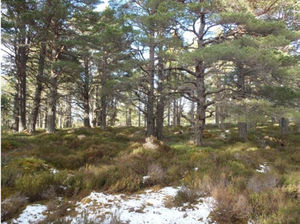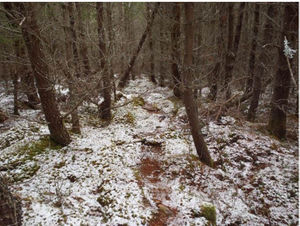OR/17/014 Introduction: Difference between revisions
m 1 revision imported |
No edit summary |
||
| Line 1: | Line 1: | ||
__notoc__ | |||
{{OR/17/014}} | {{OR/17/014}} | ||
==The proposed investigation== | ==The proposed investigation== | ||
Latest revision as of 13:23, 2 March 2018
| Archer, N A L, Everest, J. 2017. Final Report: Emergent Forest dynamics and Natural Flood Management. British Geological Survey Internal Report, OR/17/014. |
The proposed investigation
The main aim of the project is to improve our understanding of forest hydrology to contribute to better management of forests (planting/conservation) to mitigate flood risk. To do this it was proposed to investigate water flow and storage at three sites with differing vegetation: heathland/pastureland, mature scots pine plantation and ancient Caledonian forest.
Work done by BGS and the University of Dundee in the Scottish Borders has shown that the presence of established deciduous woodland has a significantly greater impact than younger coniferous plantations in increasing soil permeability, enabling heavy rainfall infiltrating the ground and reducing surface runoff, irrespective of soil type (Archer et al., 2013[1]). The majority of research based on natural flood management (NFM) and forest establishment has been undertaken in newly planted woodlands or plantations (Marshall et al., 2014[2]), where it is not possible to investigate the 'maximum potential' which the forest may attain to mitigate flood events, considering that many tree species live for more than 100 years. A preliminary survey of infiltration rates in an ancient Caledonian forest (Pinus sylvestris) considered to have existed over 4000 years), observed infiltration in relatively deep soil layers 100 times greater in comparison to a 48 year old Scots pine (Pinus sylvestris) plantation, and that infiltration rates under a newly planted Scots forest was even lower than pastureland (Archer et al., 2014[3]). This study continues such research, by focusing on the dynamic, below-ground processes of long-term root dynamics (growth and dieback), which alter below-ground water pathways and may even decouple rainfall that flows through soils to streams, as has been suggested by recent evidence (Phillips, 2010[4]). Loss of forest cover has been attributed to reductions in discharges to springs and seepages (Valdiya and Bartarya, 1989[5]).
The study will test two hypotheses:
- as these forests develop, the root system creates macropores and increases organic matter concentrations within the soil/root layer, optimising on the one hand to store water in the more organic soil and the other hand to allow water to flow via old root channels.
- springs develop within and around mature forests because their rooting systems interact with the soils in such a way as to form permanent and/or ephemeral perched water tables.
The project compares the flood mitigation potential of forest plantation, ancient forest and heathland using in-situ permeability measurements at different soil depths and investigating the frequency of springs within the three sites.
This pilot study will also examine past climate and local disturbance to deepen our understanding of forest ecosystem resilience, by taking soil cores and carrying out carbon dating and analysing polycyclic aromatic hydrocarbons (PAH) to test for disturbance (as described by Vane et al.. 2013[6]).
Field work
Following the project proposal, the fieldwork was divided into four parts:
- Site evaluation
- Survey of area and spring locations
- In-situ hydraulic conductivity measurements
- Quantifying local past disturbance of the Rothiemurchus Forest
The site evaluation and spring survey created the foundations for the project. Through this process it was concluded to modify the original proposal and focus on understanding the undulating moraine terrain in terms of spring development within adjacent plantation and Old Forest, using a re-formulated context shown in Figure 1. The proposed conceptual model focuses on UK forestry in glaciated landscapes and removed the suggested heathland areas as proposed in the original proposal. In this way we are able to focus more on the sub-surface hydrology of the undisturbed Old forest and an adjacent plantation with the aim of understanding the pedogenesis of forest soils, spring development and UK forestry in view of flood management reduction.
To investigate spring development in forest and sub-surface hydrology, the in-situ hydraulic conductivity was confined to two representative areas within a 40 year old plantation and an adjacent ~300 year old Forest. The proposed work to quantify local past disturbance of the Rothiemurchus Forest, was replaced by investigating soil moisture within the two sites and investigating the larger context of forest distribution and hydrology within the moraine terrain. The proposed changes restructured the project into the following sections.
- 1. Evaluation of Rothiemurchus area, which includes a survey of area and spring locations.
- 2. Creating a rational and choosing appropriate sites to investigate the proposed hypotheses.
- 3. Site evaluation of the chosen study areas: old Scots pine forest and mature Scots pine plantation
- 4. Investigating the wider area of the two chosen sites:
- Aerial survey of tree distributions in the old forest to understand patterning of tree distribution.
- Transect survey of peat depth survey to understand peat depth within moraine topography
- 5. Installation and analysis of automatic soil moisture sensors and rainfall within two representative sites within old forest and adjacent mature Scots pine plantation.
- 6. Measurement of in-situ hydraulic conductivity within adjacent Old forest and plantation forests.

Evaluation of Rothiemurchus area
The Rothiemurchus Forest area was evaluated on foot and by mountain bike following accessible footpaths and bicycle tracks and also a number of off-path routes were chosen. The area was evaluated in terms of forest growth, soil types and geology.
The bedrock of the Rothiemurchus area consists of micaceous psammite (sandstone). Superficial geology is mainly morainic deposits, till, glaciofluvial fan and ice deposits, alluvium in main river channels and areas of peat in topographical depressions (shown in Figure 2). The area is typical of Bog woodland in the Cairngorms, as described by Special Areas of Conservation (SAC)[note 1]. During the site evaluation it was observed that mature scots pine trees were dominant on moraine crests and were absent in the topographical depressions between moraines. According to the Forestry Commission, the chosen Old Forest (Pinus sylvestris) area was planted or left to regenerate from 1750 and the adjacent Pinus sylvestris plantation was planted using imported seed in 1971. Taking into account the glaciated topography and the relationship of the mature forest transects were chosen for the spring survey (Figure 2) with the following criteria:
- They were representative of the Rothiemurchus area
- Each site located within the plantation forest area and undisturbed forest were adjacent to each other and on similar superficial geology
- The spring survey transects crossed both plantation forest and undisturbed forest.
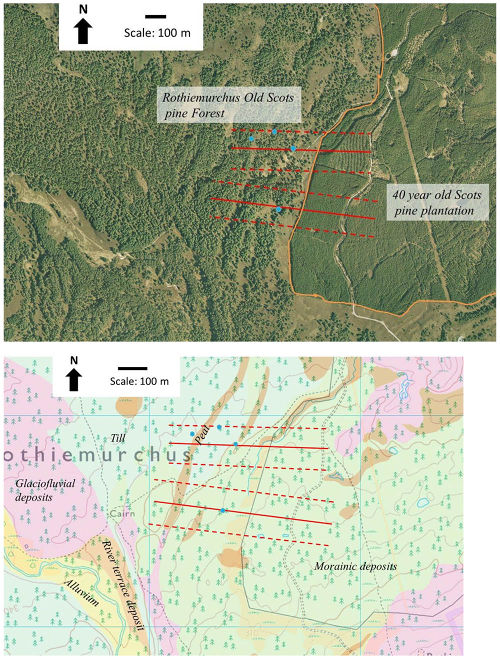
The spring survey results and discussion
During March 2015, four springs were found within the Rothiemurchus Forest and no springs were observed in the Scots pine plantation area; an example is shown in Figure 3a. The locations of the springs are given in table 1 and shown in Figure 2, as blue dots. The spring water conductivity, pH and temperature were measured and results are given in Table 1). All the springs were located near the break in slope of the moraine, which is a common position for spring occurrence due to perched water tables. Over the duration of the project these springs were observed to be permanent, even during October 2016 (the direst period during the project).
The only water found in the plantation area was stagnant open water (an example is shown in Figure 3b), situated in depressions between moraines and a flowing stream that originated from outside of the plantation. During the spring survey it was observed that there were undulating changes in elevation related to moraines within the forest plantation, which could not be seen on the aerial photographs or the digital elevation model.
Within the survey transects, dominant differences between the adjacent Old Forest and plantation areas were observed and are summarised in Table 2.
| ID | Location | Conductivity (µS/cm) | pH | Temperature (°C) |
| Spring 1 | NH 94414 07860 | 52.9 | 5.07 | 5.1 |
| Spring 2 | NH 94381 07937 | 75.2 | 6.07 | 4 |
| Spring 3 | NH 94208 07904 | 46.1 | 5.26 | 2.4 |
| Spring 4 | NH 94349 07556 | 44.3 | 4.93 | 3.8 |
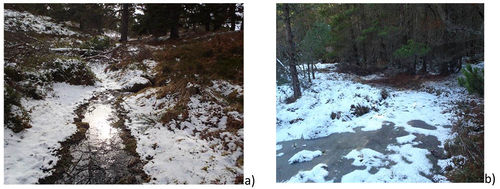
Although the Old forest and Scots pine plantation were on the same superficial geology and bedrock, the differences between them are striking as illustrated in table 2.
Considering that there was a relatively large amount of snowfall during the winter of the spring survey, the ground of the Scots pine plantation was unexpectedly dry. The absence of springs in the Scots pine plantation could be because: 1) the thick canopy cover prevents rainfall from striking and infiltrating the soil surface, 2) the relatively shallow organic soil layer causes soils to have less permeability, reducing water infiltration and 3) forest transpiration rates, reduce soil moisture. To investigate the possible reasons for the absence of springs in the plantation we used the following rationale below.
Rationale
- 3. To investigate hypothesis 1) as these forests develop, the root system creates macropores and increases organic matter concentrations within the soil/root layer, optimising on the one hand to store water in the more organic soil and the other hand to allow water to flow via old root channels, soil permeability will be investigated in terms of field saturated hydraulic conductivity (Kfs) to understand how rainfall becomes partitioned within the soil layer. The rational for this is shown in figure 4, where rainfall can be partitioned via several pathways. If rainfall intensity is higher than the maximum rate of soil infiltration, infiltration excess overland flow occurs (shown as 1 in figure 4). If rainfall is lower than maximum rate of soil infiltration, it will enter the soil system. Vertical water infiltration will continue to flow vertically if unimpeded to the groundwater aquifer flow (2 in Figure 4). If infiltrating rainfall reaches an impermeable layer (3 in Figure 4), water will flow within the sub-surface soil layer and travel laterally downslope. If the sub-surface profile becomes saturated, water will be forced under pressure to the surface, creating a spring (4, Figure 3).
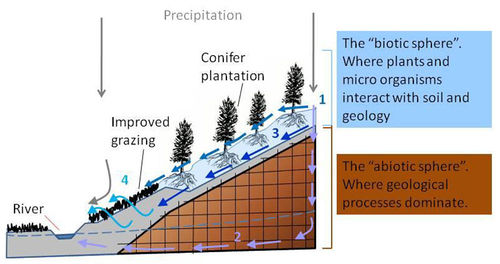
1. To investigate hypothesis 2) springs develop within and around mature forests because their rooting systems interact with the soils in such a way as to form permanent and/or ephemeral perched water tables, soil water contents, soil permeability, local topography and soil depth will be investigated. The rationale will be to understand how springs form within the moraine environment. A spring is the point where water flows out of the ground under pressure transmitted through the water, as it lies as a continuous body in the voids of sub-surface material (Bryan, 1919[7]). Springs generally are formed by perched water tables, i.e. groundwater that is separated from the main groundwater body by an impermeable layer (as shown in the conceptual model, Figure 1). In the highlands of Scotland, as explained by Averis (2003)[8], the areas where water upwells is often covered with cushions of mosses, where at the downslope edge of upwelling water a streamlet or rill may emerge.
Because of the environmental complexity of the moraine topography in Rothiemurchus, a System Thinking approach (described by (Kauffman, 1980)[9] was used to understand how the different forest types interact with the surrounding environment. Springs may form through feedback loops that facilitate constant flow of water from the water table to emerge at the ground surface, or from a perched water table (Figure 5).
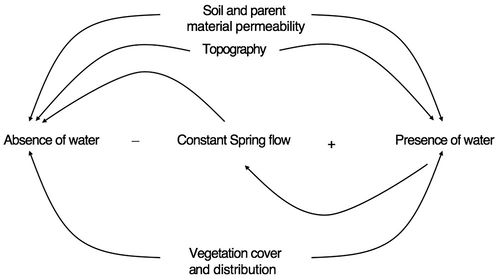
References
- ↑ Archer, N A L, Bonell, M, Coles, N, MacDonald, A M, Auton, C A, and Stevenson, R. 2013. Soil characteristics and landcover relationships on soil hydraulic conductivity at a hillslope scale: A view towards local flood management, Journal of Hydrology, 497, 208–222.
- ↑ Marshall, M R, Ballard, C E, Frogbrook, Z L, Solloway, I, McIntyre, N, Reynolds, B, and Wheater, H S. 2014. The impact of rural land management changes on soil hydraulic properties and runoff processes: results from experimental plots in upland UK, Hydrological Processes, 28, 2617–2629.
- ↑ Archer, N A L, Otten, W, Schmidt, S, Bengough, G, Shah, N, and Bonell, M. 2014. Water storage capacity and infiltration rates below ancient forest, planted forest, and grassland in view of Natural Flood Management, Submitted to Ecohydrology.
- ↑ Phillips, F M. 2010. Soil-water bypass, Nature Geoscience, 3, 77–78.
- ↑ Valdiya, K S, and Bartarya, S K. 1989. Diminishing Discharges of Mountain Springs in a Part of Kumaun Himalaya, Current Science, 58, 417–426.
- ↑ Vane, C H, Rawlins, B G, Kim, A W, Moss-Hayes, V, Kendrick, C P, and Leng, M J. 2013. Sedimentary transport and fate of polycyclic aromatic hydrocarbons (PAH) from managed burning of moorland vegetation on a blanket peat, South Yorkshire, 449, 81–94.
- ↑ Bryan, K. 1919. Classification of Springs, The Journal of Geology, 27, 522–261.
- ↑ Averis, A. 2003. Springs and Flushes, Scottish Natural Heritage, Perth, UK.
- ↑ Kauffman, D L. 1980. Systems One: An Introduction to Systems Thinking, Future Systems, Inc, St. Paul, Minnesota, USA.
